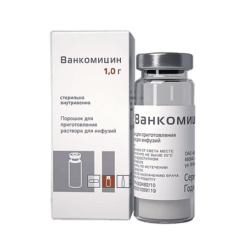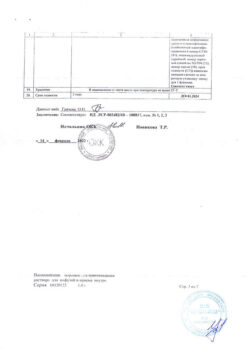No products in the cart.
Vancomycin, lyophilizate and oral administration 0.5 g
€1.00
Out of stock
(E-mail when Stock is available)
Description
An antibiotic of the glycopeptide group.
Vancomycin has a bactericidal effect.
Disrupts cell wall synthesis, cytoplasmic membrane permeability and RNA synthesis in bacteria.
Active against Gram-positive bacteria: Staphylococcus spp. (including penicillinase-producing and methicillin-resistant strains), Streptococcus spp, Enterococcus spp., Corynebacterium spp., Listeria spp., Actinomyces spp., Clostridium spp. (including Clostridium difficile). No cross-resistance with antibiotics of other groups was noted.
Indications
Indications
Severe infectious and inflammatory diseases caused by pathogens sensitive to vancomycin (with ineffectiveness or intolerance to penicillins and cephalosporins): sepsis, endocarditis, pneumonia, lung abscess, meningitis, osteomyelitis.
Pseudomembranous colitis caused by Clostridium difficile.
Pharmacological effect
Pharmacological effect
Antibiotic of the glycopeptide group.
Vancomycin has a bactericidal effect.
It disrupts the synthesis of the cell wall, the permeability of the cytoplasmic membrane and the synthesis of bacterial RNA.
Active against gram-positive bacteria: Staphylococcus spp. (including penicillinase-producing and methicillin-resistant strains), Streptococcus spp., Enterococcus spp., Corynebacterium spp., Listeria spp., Actinomyces spp., Clostridium spp. (including Clostridium difficile). No cross-resistance with antibiotics of other groups was observed.
Active ingredient
Active ingredient
Vancomycin
Composition
Composition
1 bottle contains vancomycin (in the form of hydrochloride) 0.5 g.
Pregnancy
Pregnancy
Use in the first trimester of pregnancy is contraindicated due to the risk of nephro- and ototoxicity.
The use of vancomycin in the second and third trimesters is possible only for health reasons.
If use is necessary during lactation, breastfeeding should be discontinued.
Contraindications
Contraindications
Acoustic neuritis, first trimester of pregnancy, severe renal dysfunction, increased sensitivity to vancomycin.
Side Effects
Side Effects
With rapid intravenous administration, the development of “red neck syndrome” associated with the release of histamine is possible: erythema, skin rash, redness of the face, neck, upper body, arms, rapid heartbeat, nausea, vomiting, chills, fever, fainting.
From the urinary system: urinary disorders, interstitial nephritis.
From the side of the central nervous system: hearing loss, ringing and a feeling of “fullness” in the ears.
From the hematopoietic system: neutropenia, eosinophilia, thrombocytopenia, agranulocytosis.
Allergic reactions: skin itching, urticaria, anaphylactic reactions.
Interaction
Interaction
When prescribed simultaneously with local anesthetics, erythematous rashes and hyperemia of the skin of the face may appear in children, and intracardiac conduction disturbances in adults.
Concomitant administration with nephro- and ototoxic drugs (aminoglycosides, amphotericin B, ASA or other salicylates, bacitracin, bumetanide, capreomycin, carmustine, paromomycin, cyclosporine, loop diuretics, polymyxin B, cisplatin, ethacrynic acid) is not recommended.
Cholestyramine reduces effectiveness.
Antihistamines, meclozine, phenothiazines, thioxanthenes can mask the symptoms of the ototoxic effect of vancomycin (tinnitus, vertigo).
General anesthetics and vecuronium bromide – the risk of lowering blood pressure or developing neuromuscular blockade.
Vancomycin infusion is possible at least 60 minutes before their administration.
Overdose
Overdose
Symptoms: increased severity of side effects.
Treatment: symptomatic in combination with hemoperfusion and hemofiltration.
Storage conditions
Storage conditions
In a place protected from light, at a temperature not exceeding 25 °C
Shelf life
Shelf life
2 years
Manufacturer
Manufacturer
Kraspharma PJSC, Russia
Additional information
| Shelf life | 2 years |
|---|---|
| Conditions of storage | In a light-protected place, at a temperature not exceeding 25 °C |
| Manufacturer | Kraspharma PJSC, Russia |
| Medication form | lyophilizate |
| Brand | Kraspharma PJSC |
Other forms…
Related products
Buy Vancomycin, lyophilizate and oral administration 0.5 g with delivery to USA, UK, Europe and over 120 other countries.

















